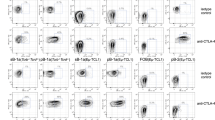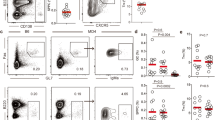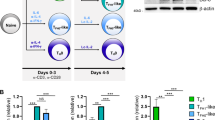Abstract
To assess the importance of B cell control of T cell differentiation, we analyzed the course of the T helper type 1 (TH1)-driven disease experimental autoimmune encephalomyelitis in mice with an altered B cell compartment. We found that recovery was dependent on the presence of autoantigen-reactive B cells. B cells from recovered mice produced interleukin 10 (IL-10) in response to autoantigen. With a bone marrow chimeric system, we generated mice in which IL-10 deficiency was restricted to B cells but not T cells. In the absence of IL-10 production by B cells, the pro-inflammatory type 1 immune response persisted and mice did not recover. These data show that B cell–derived IL-10 plays a key role in controlling autoimmunity.
This is a preview of subscription content, access via your institution
Access options
Subscribe to this journal
Receive 12 print issues and online access
$209.00 per year
only $17.42 per issue
Buy this article
- Purchase on Springer Link
- Instant access to full article PDF
Prices may be subject to local taxes which are calculated during checkout






Similar content being viewed by others
References
Miller, J.F. & Basten, A. Mechanisms of tolerance to self. Curr. Opin. Immunol. 8, 815–821 (1996).
Fulcher, D.A. et al. The fate of self-reactive B cells depends primarily on the degree of antigen receptor engagement and availability of T cell help. J. Exp. Med. 183, 2313–2328 (1996).
Chan, O. & Shlomchik, M.J. A new role for B cells in systemic autoimmunity: B cells promote spontaneous T cell activation in MRL-lpr/lpr mice. J. Immunol. 160, 51–59 (1998).
Martin, R. & McFarland, H.F. Immunological aspects of experimental allergic encephalomyelitis and multiple sclerosis. Crit. Rev. Clin. Lab. Sci. 32, 121–182 (1995).
Kuchroo, V.K. et al. Cytokines and adhesion molecules contribute to the ability of myelin proteolipid protein-specific T cell clones to mediate experimental allergic encephalomyelitis. J. Immunol. 151, 4371–4382 (1993).
Iglesias, A., Bauer, J., Litzenburger, T., Schubart, A. & Linington, C. T- and B-cell responses to myelin oligodendrocyte glycoprotein in experimental autoimmune encephalomyelitis and multiple sclerosis. Glia 36, 220–234 (2001).
Myers, K.J., Sprent, J., Dougherty, J.P. & Ron, Y. Synergy between encephalitogenic T cells and myelin basic protein-specific antibodies in the induction of experimental autoimmune encephalomyelitis. J. Neuroimmunol. 41, 1–8 (1992).
Wolf, S.D., Dittel, B.N., Hardardottir, F. & Janeway, C.A. Jr. Experimental autoimmune encephalomyelitis induction in genetically B cell-deficient mice. J. Exp. Med. 184, 2271–2278 (1996).
Day, M.J., Tse, A.G., Puklavec, M., Simmonds, S.J. & Mason, D.W. Targeting autoantigen to B cells prevents the induction of a cell-mediated autoimmune disease in rats. J. Exp. Med. 175, 655–659 (1992).
Saoudi, A., Simmonds, S., Huitinga, I. & Mason, D. Prevention of experimental allergic encephalomyelitis in rats by targeting autoantigen to B cells: evidence that the protective mechanism depends on changes in the cytokine response and migratory properties of the autoantigen-specific T cells. J. Exp. Med. 182, 335–344 (1995).
Khoury, S.J., Hancock, W.W. & Weiner, H.L. Oral tolerance to myelin basic protein and natural recovery from experimental autoimmune encephalomyelitis are associated with downregulation of inflammatory cytokines and differential upregulation of transforming growth factor β, interleukin 4, and prostaglandin E expression in the brain. J. Exp. Med. 176, 1355–1364 (1992).
Kennedy, M.K., Torrance, D.S., Picha, K.S. & Mohler, K.M. Analysis of cytokine mRNA expression in the central nervous system of mice with experimental autoimmune encephalomyelitis reveals that IL-10 mRNA expression correlates with recovery. J. Immunol. 149, 2496–2505 (1992).
Bettelli, E. et al. IL-10 is critical in the regulation of autoimmune encephalomyelitis as demonstrated by studies of IL-10- and IL-4-deficient and transgenic mice. J. Immunol. 161, 3299–3306 (1998).
Samoilova, E.B., Horton, J.L. & Chen, Y. Acceleration of experimental autoimmune encephalomyelitis in interleukin-10-deficient mice: roles of interleukin-10 in disease progression and recovery. Cell. Immunol. 188, 118–124 (1998).
Skok, J., Poudrier, J. & Gray, D. Dendritic cell-derived IL-12 promotes B cell induction of Th2 differentiation: a feedback regulation of Th1 development. J. Immunol. 163, 4284–4291 (1999).
Kitamura, D. & Rajewsky, K. Targeted disruption of μ chain membrane exon causes loss of heavy-chain allelic exclusion. Nature 356, 154–156 (1992).
Mendel, I., Derosbo, N.K. & Bennun, A. A myelin oligodendrocyte glycoprotein peptide induces typical chronic experimental autoimmune encephalomyelitis in H-2(B) mice - fine specificity and T-cell receptor V-β expression of encephalitogenic T-cells. Eur. J. Immunol. 25, 1951–1959 (1995).
Lyons, J.A., San, M., Happ, M.P. & Cross, A.H. B cells are critical to induction of experimental allergic encephalomyelitis by protein but not by a short encephalitogenic peptide. Eur. J. Immunol. 29, 3432–3439 (1999).
Goodnow, C.C. et al. Altered immunoglobulin expression and functional silencing of self-reactive B lymphocytes in transgenic mice. Nature 334, 676–682 (1988).
Mauri, C., Mars, L.T. & Londei, M. Therapeutic activity of agonistic monoclonal antibodies against CD40 in a chronic autoimmune inflammatory process. Nature Med. 6, 673–679 (2000).
Mizoguchi, A., Mizoguchi, E., Takedatsu, H., Blumberg, R.S. & Bhan, A.K. Chronic intestinal inflammatory condition generates IL-10-producing regulatory B cell subset characterized by CD1d upregulation. Immunity 16, 219–230 (2002).
Singh, A.K. et al. Natural killer T cell activation protects mice against experimental autoimmune encephalomyelitis. J. Exp. Med. 194, 1801–1811 (2001).
Colgan, S.P., Hershberg, R.M., Furuta, G.T. & Blumberg, R.S. Ligation of intestinal epithelial CD1d induces bioactive IL-10: critical role of the cytoplasmic tail in autocrine signaling. Proc. Natl. Acad. Sci. USA 96, 13938–13943 (1999).
Herzenberg, L.A. B-1 cells: the lineage question revisited. Immunol. Rev. 175, 9–22 (2000).
Rothstein, T.L. Cutting edge commentary: two B-1 or not to be one. J. Immunol. 168, 4257–4261 (2002).
O'Garra, A. et al. Ly-1 B (B-1) cells are the main source of B cell-derived interleukin 10. Eur. J. Immunol. 22, 711–717 (1992).
Whitmore, A.C., Haughton, G. & Arnold, L.W. Phenotype of B cells responding to the thymus-independent type-2 antigen polyvinyl pyrrolidinone. Int. Immunol. 8, 533–542 (1996).
Segal, B.M., Dwyer, B.K. & Shevach, E.M. An interleukin (IL)-10/IL-12 immunoregulatory circuit controls susceptibility to autoimmune disease. J. Exp. Med. 187, 537–546 (1998).
Xiao, B.G., Bai, X.F., Zhang, G.X. & Link, H. Suppression of acute and protracted-relapsing experimental allergic encephalomyelitis by nasal administration of low-dose IL-10 in rats. J. Neuroimmunol. 84, 230–237 (1998).
Cannella, B., Gao, Y.L., Brosnan, C. & Raine, C.S. IL-10 fails to abrogate experimental autoimmune encephalomyelitis. J. Neurosci. Res. 45, 735–746 (1996).
Croxford, J.L., Feldmann, M., Chernajovsky, Y. & Baker, D. Different therapeutic outcomes in experimental allergic encephalomyelitis dependent upon the mode of delivery of IL-10: a comparison of the effects of protein, adenoviral or retroviral IL-10 delivery into the central nervous system. J. Immunol. 166, 4124–4130 (2001).
Mathisen, P.M., Yu, M., Johnson, J.M., Drazba, J.A. & Tuohy, V.K. Treatment of experimental autoimmune encephalomyelitis with genetically modified memory T cells. J. Exp. Med. 186, 159–164 (1997).
Cua, D.J., Groux, H., Hinton, D.R., Stohlman, S.A. & Coffman, R.L. Transgenic interleukin 10 prevents induction of experimental autoimmune encephalomyelitis. J. Exp. Med. 189, 1005–1010 (1999).
Stockinger, B., Zal, T., Zal, A. & Gray, D. B cells solicit their own help from T cells. J. Exp. Med. 183, 891–899 (1996).
Macaulay, A.E., DeKruyff, R.H., Goodnow, C.C. & Umetsu, D.T. Antigen-specific B cells preferentially induce CD4+ T cells to produce IL-4. J. Immunol. 158, 4171–4179 (1997).
Harris, D.P. et al. Reciprocal regulation of polarized cytokine production by effector B and T cells. Nature Immunol. 1, 475–482 (2000).
Moulin, V. et al. B lymphocytes regulate dendritic cell (DC) function in vivo: increased interleukin 12 production by DCs from B cell-deficient mice results in T helper cell type 1 deviation. J. Exp. Med. 192, 475–482 (2000).
Maldonado-Lopez, R., Maliszewski, C., Urbain, J. & Moser, M. Cytokines regulate the capacity of CD8α(+) and CD8α(−) dendritic cells to prime Th1/Th2 cells in vivo. J. Immunol. 167, 4345–4350 (2001).
D'Amico, G. et al. Uncoupling of inflammatory chemokine receptors by IL-10: generation of functional decoys. Nature Immunol. 1, 387–391 (2000).
Cumberbatch, M., Dearman, R.J. & Kimber, I. Langerhans cells require signals from both tumour necrosis factor-α and interleukin-1β for migration. Immunology 92, 388–395 (1997).
Kuhn, R., Lohler, J., Rennick, D., Rajewsky, K. & Muller, W. Interleukin-10-deficient mice develop chronic enterocolitis. Cell 75, 263–274 (1993).
Kawabe, T. et al. The immune responses in CD40-deficient mice: impaired immunoglobulin class switching and germinal center formation. Immunity 1, 167–178 (1994).
Xu, J. et al. Mice deficient for the CD40 ligand. Immunity 1, 423–431 (1994).
Beech, J.T., Bainbridge, T. & Thompson, S.J. Incorporation of cells into an ELISA system enhances antigen-driven lymphokine detection. J. Immunol. Meth. 205, 163–168 (1997).
Rolink, A., Melchers, F. & Andersson, J. The SCID but not the RAG-2 gene product is required for Sμ-Sɛ heavy chain class switching. Immunity 5, 319–330 (1996).
Acknowledgements
Supported by grants from the Medical Research Council UK and the Wellcome Trust and by the Wellcome Trust (D.G.) and Medical Research Council (S. M. A).
Author information
Authors and Affiliations
Corresponding author
Ethics declarations
Competing interests
The authors declare no competing financial interests.
Rights and permissions
About this article
Cite this article
Fillatreau, S., Sweenie, C., McGeachy, M. et al. B cells regulate autoimmunity by provision of IL-10. Nat Immunol 3, 944–950 (2002). https://doi.org/10.1038/ni833
Received:
Accepted:
Published:
Issue Date:
DOI: https://doi.org/10.1038/ni833
This article is cited by
-
The role of regulatory B cells in immune regulation and childhood allergic asthma
Molecular and Cellular Pediatrics (2024)
-
Myeloid-derived suppressor cells cross-talk with B10 cells by BAFF/BAFF-R pathway to promote immunosuppression in cervical cancer
Cancer Immunology, Immunotherapy (2023)
-
PD-L1 is required for estrogen-induced protection against severe EAE in IL-10 deficient mice1
Metabolic Brain Disease (2023)
-
Modulation of Mesenchymal Stem Cells-Mediated Adaptive Immune Effectors’ Repertoire in the Recovery of Systemic Lupus Erythematosus
Stem Cell Reviews and Reports (2023)
-
IL-10-providing B cells govern pro-inflammatory activity of macrophages and microglia in CNS autoimmunity
Acta Neuropathologica (2023)



